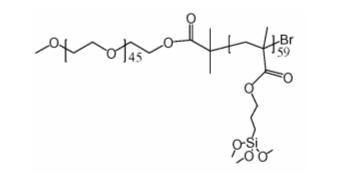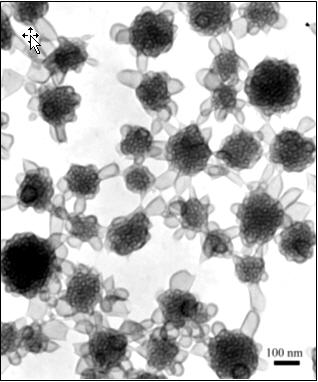| |
Du, Jianzhong; Chen, Yongming.
Block copolymers spontaneously self-organize into nanometer-scale structures and are therefore of great interest for emerging nanomaterials and nanotechnologies. If one segment of block copolymers bears reactive groups, the resulting aggregates can be fixed by chemical cross-linking. Such nanoparticles are shape-persistent, even with changes in the environment. Recently, a reactive amphiphilic block copolymer, poly(ethylene oxide)-block-poly[3-(trimethoxysilyl)propyl methacrylate] (PEO-b-PTMSPMA, Scheme 1) was prepared by atom transfer radical polymerization (Macromolecules 2004, 37, 6322). Novel hollow organic/inorganic hybrid particles were produced based on self-assembling in a methanol/water mixture and gelation process inside the aggregates (J. Am. Chem. Soc. 2003, 125, 14710; Macromolecules 2004, 37, 5710).
Herein, organic–inorganic hybrid particles with complex hollow structures were prepared simply by the gelation of trimethoxylsilyl groups in the preformed self-assembly of PEO-b-PTMSPMA in DMF/water solution. Inside the resulting particle, there are many cavities insulated by cross-linked hybrid bilayers of uniform thickness. Owing to gelation, the morphology of particles is stable against drastic changes in conditions. The potential application of such novel nanomaterials in encapsulation is very promising. For example, as there are many cavities inside the particles, it may be possible to encapsulate functional species into different cavities of a particle for stepwise-release.
Angew. Chem. Int. Ed. 2004, 43, 5084-5087.

The structure of poly(ethylene oxide)-block-poly[3-(trimethoxysilyl) propyl methacrylate] (PEO-b-PTMSPMA).

Possible mechanism for the formation of hybrid large-compound vesicles (LCVs): Simple vesicles collide each other and then fuse into LCVs. The triethylamine (TEA) catalyzes the hydrolysis and polycondensation reactions. Yellow: PEO, blue: PTMSPMA, red: polyorganosiloxane from the sol–gel processes of PTMSPMA.

Typical TEM (A, B, C, D, and F) and (E) SEM images of complex hollow particles. The initial polymer concentration in DMF (Ci) is 0.1 (A), 2.0 (B, C), and 20.0 m/gmL (D, E, F). Water content is 51.4 wt%, except for C (94 wt %). F: TEM image of a smaller flower and fallen petals.

TEM image of the flower-like complex hollow particles.
, |
|
